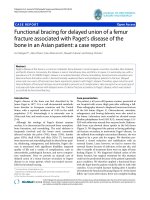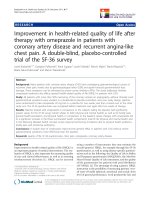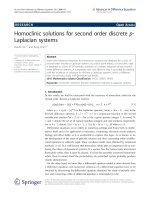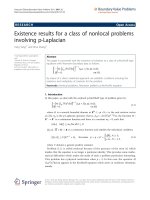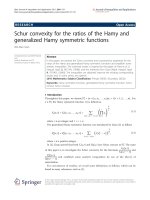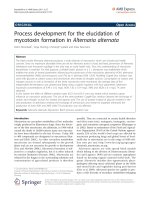báo cáo hóa học:" Extremal solutions for certain type of fractional differential equations with maxima" pptx
Bạn đang xem bản rút gọn của tài liệu. Xem và tải ngay bản đầy đủ của tài liệu tại đây (143.17 KB, 14 trang )
Advances in Difference
Equations
This Provisional PDF corresponds to the article as it appeared upon acceptance. Fully formatted
PDF and full text (HTML) versions will be made available soon.
Extremal solutions for certain type of fractional differential equations with
maxima
Advances in Difference Equations 2012, 2012:7
doi:10.1186/1687-1847-2012-7
Rabha W Ibrahim ()
ISSN
Article type
1687-1847
Research
Submission date
13 September 2011
Acceptance date
8 February 2012
Publication date
8 February 2012
Article URL
/>
This peer-reviewed article was published immediately upon acceptance. It can be downloaded,
printed and distributed freely for any purposes (see copyright notice below).
For information about publishing your research in Advances in Difference Equations go to
/>For information about other SpringerOpen publications go to
© 2012 Ibrahim ; licensee Springer.
This is an open access article distributed under the terms of the Creative Commons Attribution License ( />which permits unrestricted use, distribution, and reproduction in any medium, provided the original work is properly cited.
Extremal solutions for certain type of fractional
differential equations with maxima
Rabha W Ibrahim
Institute of Mathematical Sciences, University Malaya, 50603 Kuala Lumpur, Malaysia
Email address:
Abstract
In this article, we employ the Tarski’s fixed point theorem to establish the existence of extremal
solutions for fractional differential equations with maxima.
1
Introduction
Fractional calculus has become an exciting new mathematical method of solution of diverse
problems in mathematics, science, and engineering. Indeed, recent advances of fractional calculus are dominated by modern examples of applications in differential and integral equations
1
and inclusions, physics, signal processing, fluid mechanics, viscoelasticity, mathematical biology, engineering, dynamical systems, control theory, electrical circuits, generalized voltage
divider, computer sciences, and electrochemistry (see [1, 2]).
The theory and applications of fractional differential equations received in recent years considerable interest both in pure mathematics and in applications. There exist several different
definitions of fractional differentiation. Whereas in mathematical treatises on fractional differential equations the Riemann–Liouville approach to the notion of the fractional derivative
is normally used [3–5], the Caputo fractional derivative often appears in applications [6],
Erd`lyi–Kober fractional derivative [7] and The Weyl–Riesz fractional operators [8]. There
e
are some advantages in studying the extremal solution for fractional differential equations,
because some boundary conditions are automatically fulfilled and due to lower order differential requirements (see [9]).
Differential equations with maximum arise naturally when solving practical and phenomenon problems, in particular, in those which appear in the study of systems with automatic regulation and automatic control of various technical systems. It often occurs that
the law of regulation depends on maximum values of some regulated state parameters over
certain time intervals. Many studies of the existence of solutions are imposed such as periodicity, asymptotic stability and oscillatory [10–12]. In [13], the authors discusses the existence
of univalent solutions for fractional integral equations with maxima in complex domain, by
using technique associated with measures of non-compactness.
In this article, we establish the extreme solutions (maximal and minimal solutions) for
fractional differential equation with maxima in sense of Riemann–Liouville fractional operators, by using the Tarski’s fixed point theorem. Moreover, we extend the existence of
extremal solutions from initial value problems to boundary value problems for infinite quasimonotone functional systems of fractional differential equations.
2
Preliminaries
The ordered set (poset) X is called a lattice if sup{x1 , x2 } and inf{x1 , x2 } exist for all
x1 , x2 ∈ X. A lattice X is complete when each nonempty subset Y ⊂ X has the supremum
2
and the infimum in X. In particular, every complete lattice has the maximum and the
minimum. Denoted by
[a, b]X = {x ∈ X : a ≤ x ≤ b}.
The fundamental tool in our work is the following well-known Tarski’s fixed point theorem
which can be found in [14]:
Theorem 2.1. Every nondecreasing mapping G : X → X on a complete lattice X has a
minimal, x∗ , and a maximal fixed point, x∗ . Moreover,
x∗ = max{x ∈ X : x ≤ Gx}.
x∗ = min{x ∈ X : Gx ≤ x},
Let T > 0 and η > 0 be fixed. We denote by AC([0, T ]) the set of all functions x : [0, T ] →
R which are absolutely continuous and by B([−η, 0]) the set of all functions x : [−η, 0] → R
which are bounded. Let M be an arbitrary index set and for each for all ȷ ∈ M, hȷ : [0, T ] → R
be a Lebesgue-integrable function and define
∫t
Chȷ ([0, T ]) = x : [0, T ] → R, |x(s) − x(t)| ≤
hȷ (η)dη ,
s
s, t ∈ J := [0, T ] ,
with the property
x1 , x2 ∈ Chȷ ([0, T ]),
x1 ≤ x2 ⇔ x1 (t) ≤ x2 (t),
∀t ∈ [0, T ].
Also, we define the set
{
}
Sȷ = ξ : [−η, T ] → R : ξ|[−η,0] ∈ B([−η, 0]) and ξ|[0,T ] ∈ Chȷ ([0, T ])
satisfies
ξ1 , ξ2 ∈ Sȷ ,
ξ1 ≤ ξ2 ⇔ ξ1 (t) ≤ ξ2 (t),
And set
S=
∏
Sȷ ,
t ∈ [−η, T ].
ȷ∈M
ȷ∈M
satisfies
γ, λ ∈ S,
γ ≤ λ ⇔ γȷ ≤ λȷ ,
3
ȷ ∈ M.
One of the most frequently used tools in the theory of fractional calculus is furnished by
the Riemann–Liouville operators (see [15]).
Definition 2.1. The fractional (arbitrary) order integral of the function f of order α > 0
is defined by
∫t
α
Ia f (t)
=
(t − τ )α−1
f (τ )dτ.
Γ(α)
a
When a = 0, we write
α
Ia f (t) = I α f (t) = f (t) ∗ ϕα (t),
where (∗) denoted the convolution product,
ϕα (t) =
tα−1
,t>0
Γ(α)
and ϕα (t) = 0, t ≤ 0 and ϕα → δ(t) as α → 0 where δ(t) is the delta function.
Definition 2.2. The fractional (arbitrary) order derivative of the function f of order 0 <
α < 1 is defined by
α
Da f (t)
d
=
dt
∫t
a
3
(t − τ )−α
d 1−α
f (τ )dτ = Ia f (t).
Γ(1 − α)
dt
Main results
We study fractional differential equations with maxima of the form
)
(
F t, u(t), maxs∈J u(s)
if t ∈ J;
Dα u(t) =
u(θ) = ϕ(θ)
if θ ∈ [−η, 0],
(1)
where F : J × R × S → R and ϕ : [−η, 0] → R. We denote by ∥ϕ∥ the norm
∥ϕ∥ = max{ϕ(θ) : θ ∈ [−η, 0]}.
Definition 3.1. We say that uȷ ∈ S is a lower solution of problem (1) if for each ȷ ∈ M we
have
(
)
Dα uȷ (t) ≤ Fȷ t, u(t), max u(s) ,
s∈J
t ∈ J;
4
uȷ (θ) ≤ ϕ(θ),
θ ∈ [−η, 0].
(2)
Analogously we say that uȷ is an upper solution of (1) if the above inequalities are reversed.
We say that uȷ is a solution of (1) if it is both a lower and an upper solution. A solution
u∗ in A ⊂ S is a maximal solution in the set A if u∗ ≥ u for any other solution u ∈ A.
The minimal solution in A is defined analogously by reversing the inequalities; when both a
minimal and a maximal solution in A exist, we call them the extremal solutions in A.
Next we pose our main result
Theorem 3.1. Assume that there exist γ, λ ∈ S with γ ≤ λ such that the following
hypotheses hold:
(i) For each ξ ∈ [γ, λ]S the initial value problem
Dα zȷ (t) =
)
(
F t, z(t), max z(s)
ȷ
t ∈ J;
s∈J
z (0) = ϕ(0)
ȷ
(3)
has a maximal solution z ∗ and a minimal solution z∗ in A := [γȷ , λȷ ]Chȷ ([0,T ])
(ii) For each ξ ∈ [γ, λ]S , ȷ ∈ M and t ∈ J if u(t) ≤ v(t) and uȷ = vȷ then
(
)
(
)
Fȷ t, u(t), ξ ≤ Fȷ t, v(t), ξ .
(iii)
(
)
The function Fȷ t, u(t), . is nondecreasing in [γ, λ]S . Moreover, the function ϕ is
nondecreasing in [−η, 0].
Then problem (1) has a maximal solution, u∗ , and a minimal one, u∗ , in [γ, λ]S .
Proof. We shall prove the existence of the maximal solution since the existence of the
minimal solution follows from the dual arguments.
Firstly we consider the mapping
Φȷ : [γ, λ]S → [γȷ , λȷ ]Sȷ
5
then in virtue of condition (i) we can define
ϕ (θ) if θ ∈ [−η, 0];
ξ
(Φȷ ξ) =
∗
ξ (t) if t ∈ J,
(4)
where ξ ∗ is the the maximal solution in [γȷ , λȷ ]Chȷ ([0,T ]) of the problem (3). Therefore (Φȷ ξ) ∈
[γȷ , λȷ ]Sȷ . Secondly, we impose the mapping
Φ : [γ, λ]S → [γ, λ]S .
Next we proceed to prove that Φ satisfies the conditions of Theorem 2.1.
Step 1. Φ : [γ, λ]S → [γ, λ]S is nondecreasing.
Let ξ1 , ξ2 ∈ [γ, λ]S and fix ȷ ∈ M. By (iii) we have
(Φȷ ξ1 )(θ) = ϕξ1 (θ) ≤ ϕξ2 (θ) = (Φȷ ξ2 )(θ),
θ ∈ [−η, 0].
On the other hand, Φȷ ξ ∈ A and in view of conditions (ii) and (iii) we obtain that
(Φȷ ξ1 ) ≤ (Φȷ ξ2 ),
on J.
Since ȷ ∈ M is arbitrary we conclude that (Φξ1 ) ≤ (Φξ2 ).
Step 2. [γ, λ]S is a complete lattice.
It suffices to prove that for each ȷ ∈ M the set [γȷ , λȷ ]Sȷ is a complete lattice. Let B ⊂ [γȷ , λȷ ]Sȷ
this implies that B ̸= ∅ and B has the supremum and the infimum. Define
ξ ∗ (t) = sup{ξ(t) : ξ ∈ B,
t ∈ [−η, T ]}.
It is clear that ξ ∗ (t) is well defined for all t ∈ [−η, T ] and satisfies γȷ ≤ ξ ∗ ≤ λȷ i.e, ξ ∗ is
bounded on [−η, 0]. Finally we shall prove that ξ ∗ ∈ A. For fix t, s ∈ J and ξ ∈ B we observe
6
that
∫t
ξ(s) ≤ |ξ(s) − ξ(t)| + ξ(t) ≤
hȷ (r)dr + ξ ∗ (t)
s
∫t
⇒ sup ξ(s) ≤
hȷ (r)dr + ξ ∗ (t)
s
⇒ ξ ∗ (s) ≤
∫t
hȷ (r)dr + ξ ∗ (t)
s
⇒ ξ ∗ (t) ≤
∫s
hȷ (r)dr + ξ ∗ (s)
t
∗
∗
∫t
⇒ |ξ (s) − ξ (t)| ≤
hȷ (r)dr .
s
Therefor ξ ∗ ∈ [γȷ , λȷ ]Sȷ and ξ ∗ = sup B. The existence of inf B is proved by similar manner.
∏
Hence [γȷ , λȷ ]Sȷ is a complete lattice and consequently [γ, λ]S = ȷ∈M [γȷ , λȷ ]Sȷ .
Steps 1 and 2 imply that Φ satisfies the conditions of Tarski’s fixed point theorem and then
Φ has the maximal fixed point x∗ which satisfies
x∗ = max{x ∈ [γ, λ]S : x ≤ Φx}.
(5)
Step 3. x∗ is the maximal solution of problem (1) in [γ, λ]S .
By the definition of Φ we have u∗ is a solution for the problem (1). Suppose now that
u := uȷ )ȷ∈M ∈ [γ, λ]S is a lower solution for (1) i.e.
)
(
F t, u(t), max u(s)
if t ∈ J;
ȷ
s∈J
Dα uȷ (t) ≤
uȷ (θ) ≤ ϕ(θ)
if θ ∈ [−η, 0].
(6)
Then by (5) it follows that for every solution x of the problem (1) satisfies x ≤ x∗ . This
completes the proof of Theorem 3.1.
7
Remark 3.1. Note that Condition (i) in Theorem 3.1 looks difficult to verify but it is useful
for applying the Theorem 2.1. however, there are in the literature a lot of sufficient conditions
which imply the existence of extremal solutions. Condition (ii) is called quasimonotonicity.
This property is important for extremal fixed points of discontinuous maps. Moreover,
the functional boundary condition u(θ) = ϕ(θ),
θ ∈ [−η, 0] includes the initial condition
u(0) = ϕ(0) := u0 , where θ = 0. As well as several types of periodic conditions, which have
more interest, such as the ordinary periodic condition u(θ) = ϕ(θ) := u(T ) for fixed θ which
probably takes the value θ = 0. Moreover, the functional periodic condition x(θ) = ϕ(θ) :=
x(θ + T ),
θ ∈ [−η, 0]. Finally, ϕ(t) can represented as integral initial condition such as
∫T
uȷ (s)ds.
u(0) =
0
Additional condition on ξ ∈ S, for all ȷ ∈ M if ξȷ is Lebesgue-measurable on [−η, 0] leads to
suggest the initial condition
T
∫ /2
u(0) =
uȷ (s)ds.
−η
Next we replace the condition (i) by assuming F in the set of L1 (J, R × R)−Carath´odory.
e
X
Definition 3.2. A mapping p : J × R → R is said to be Carath´odory if
e
(C1) t → p(t, u) is measurable for each u ∈ R,
(C2) u → p(t, u) is continuous a.e. for t ∈ J.
A Carath´odory function p(t, u) is called L1 (J, R)−Carath´odory if
e
e
(C3) for each number r > 0 there exists a function hr ∈ L1 (J, R) such that |p(t, u)| ≤ hr (t)
a.e t ∈ J for all u ∈ R with |u| ≤ r.
A Carath´odory function p(t, u) is called L1 (J, R)−Carath´odory if
e
e
X
(C4) there exists a function h ∈ L1 (J, R) such that |p(t, u)| ≤ h(t) a.e t ∈ J for all u ∈ R
where h is called the bounded function of p.
8
Theorem 3.2. Let F be L1 (J, R)−Carath´odory. If the assumptions (ii) and (iii) hold
e
X
then the problem (1) has at least one solution u(t) on J.
Proof. Operating equation (1) by I α and using the properties of the fractional operators
(see [9, 15]), we have
∫t
(t − τ )α−1
F (τ, u, v)dτ.
Γ(α)
u(t) = ϕ(θ) +
0
Define an operator P as follows :
∫t
(P u)(t) := ϕ(θ) +
(t − τ )α−1
F (τ, u, v)dτ.
Γ(α)
(7)
0
Then by the assumption of the theorem and the properties of the fractional calculus we
obtain that
∫t
(t − τ )α−1
|F (τ, u, v)|dτ
Γ(α)
|(P u)(t)| ≤ ∥ϕ∥ +
0
∫t
≤ |ϕ(θ)| +
(t − τ )α−1
h(τ )dτ
Γ(α)
0
∫t
≤ ∥ϕ∥ + ∥h∥
L1
(t − τ )α−1
dτ
Γ(α)
0
≤ ∥ϕ∥ +
∥h∥L1 T α
Γ(α + 1)
:= ρ.
This further implies that
∥P u∥C ≤ ρ,
where C[(J, R×R)] is the space of all continuous real valued functions on J with a supremum
norm ∥.∥C that is P : Bρ → Bρ . Therefore, P maps Bρ into itself. In fact, P maps the convex
closure of P [Bρ ] into itself. Since f is bounded on Bρ , thus P [Bρ ] is equicontinuous and the
Schauder fixed point theorem shows that P has at least one fixed point u ∈ A such that
9
P u = u, which is corresponding to solution of the problem (1). To obtain the maximal and
minimal solutions, we use the same arguments in Theorem 3.1.
Moreover condition (i) can replaced by letting F in the set of all functions which are µ −
Lipschitz. We have the following definition:
Definition 3.3. A function F (t, u, v) : J × R × S → R is called
(i) a µ − Lipschitz if and only if there exists a positive constant µ such that
[
]
F (t, u1 , v1 ) − F (t, u2 , v2 ) ≤ µ ∥u1 − u2 ∥ + ∥v1 − v2 ∥ ,
where
∥.∥ = sup {|.|},
t,s∈J
and the constant µ is called a Lipschitz constant.
(ii) A contraction if and only if it is µ − Lipschitz with µ < 1.
Theorem 3.3. Let F be µ − Lipschitz. If
µT α
Γ(α+1)
< 1, then (1) has a unique solution u(t)
on J.
Proof. Assume the operator P defined in Equation (6) then we have
∫t
|(P u1 )(t) − (P u2 )(t)| ≤
(t − τ )α−1
|F (τ, u1 , v1 ) − F (τ, u2 , v2 )|dτ
Γ(α)
0
∫t
≤ µ(∥u1 − u2 ∥ + ∥v1 − v2 ∥)
(t − τ )α−1
dτ
Γ(α)
0
≤
α
µT
(∥u1 − u2 ∥ + ∥v1 − v2 ∥).
Γ(α + 1)
Hence by the assumption of the theorem we have that P is a contraction mapping then in
view of the Banach fixed point theorem, P has a unique fixed point which is corresponding
to the solution of Equation (1). In this case u(t) = u∗ (t) = u∗ (t).
Example 3.1. Let J = [0, 1] denote a closed and bounded interval in R. Consider the
problem
10
0,
[
]
u(t)
α
D u(t) =
h(t), h(t) exp 2 ,
u(0) = h(0) = 0.
if u < 0;
if u ≥ 0
(8)
e
It is clear that F is L1 (J, R)−Carath´odory with any decreasing growth function h ∈
X
L1 (J, R+ ) such that ∥F (t, u)∥ ≤ h(t) a.e t ∈ J for all u ∈ R. Therefore in view of Theorem
3.2, the problem (8) has maximal and minimal solutions.
Example 3.2. Let S be any nonmeasurable set such that S ⊂ [0, 1]. Consider the problem
Dα u(t) =
1,
1,
if u > t, t ∈ J;
if u = t, t ∈ S
0,
u(0) = 0.
(9)
otherwise.
Obviously F does not satisfy the condition (i) of Theorem 3.1, and hence the problem (9)
hasn’t extremal solutions.
Competing interests
The authors declare that they have no competing interests.
Acknowledgements
This research has been funded by the University Malaya, under the Grant No. RG20811AFR.
11
References
1. Lewandowski, R, Chorazyczewski, B: Identification of the parameters of the KelvinVoigt and
the Maxwell fractional models, used to modeling of viscoelastic dampers. Comput. Struct. 88
(2010) 1–17.
2. Yu, F: Integrable coupling system of fractional soliton equation hierarchy. Phys. Lett. A 373
(2009) 3730–3733.
3. Ibrahim, RW: Existence of convex and non convex local solutions for class of fractional differential inclusion, Electron. J. Diff. Equ. 2009(15) (2009) 1–15.
4. Ibrahim, RW: Continuous solutions for fractional integral inclusion in locally convex topological
space. Appl. Math. J. Chin. Univ. 24(2) (2009) 175–183.
5. Ibrahim, RW: On the existence for diffeo-integral inclusion of Sobolev-type of fractional order
with applications, ANZIAM J. 52(E) (2010) 1–21.
6. Ibrahim, RW: Initial and boundary value problems for inclusions involving Caputo’s fractional
derivatives, Pure Math. Appl. 18(1) (2007) 1-14.
7. Ibrahim RW, Momani, S: On the existence and uniqueness of solutions of a class of fractional
differential equations. J. Math. Anal. Appl. 334 (2007) 1–10.
8. Momani, SM, Ibrahim, RW: On a fractional integral equation of periodic functions involving
Weyl–Riesz operator in Banach algebras. J. Math. Anal. Appl. 339 (2008) 1210–1219.
9. Lakshmikantham, V, Leela, S, Vasundhara, J: Theory of Fractional Dynamic Systems. Cambridge Academic Publishers, Cambridge (2009).
12
10. Golev, A, Hristova, S, Rahnev, A: An algorithm for approximate solving of differential equations
with maxima. Comput. Math. Appl. 60(10), (2010) 2771–2778.
11. Mishev, DP, Musa, SM: Distribution of the zeros of the solutions of hyperbolic differential
equations with maxima. Rocky Mt. J. Math. 37(4) (2007) 1271–1281.
12. Otrocol, D, Rus, IA: Functional differential equations with maxima of mixed type. Fixed Point
Theory 9(1) (2008) 207–220.
13. Ibrahim, RW, Darus, M: A Note on the existence of fractional integral equations. Adv. Stud.
Theory Phys. 4(14) (2010) 653–663.
14. Tarski, A: A lattice-theoretical fixed point theorem and its applications. Pac. J. Math. 5 (1955)
285–309.
15. Kilbas, AA, Srivastava, HM, Trujillo, JJ: Theory and Applications of Fractional Differential
Equations. North-Holland, Mathematics Studies. Elsevier, Amsterdam (2006).
13




